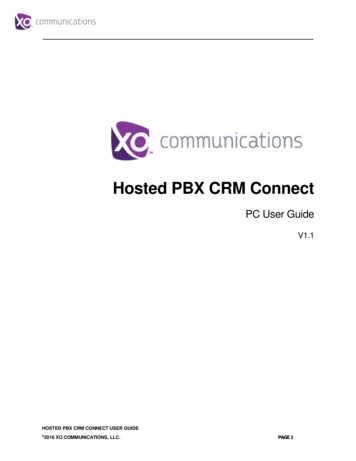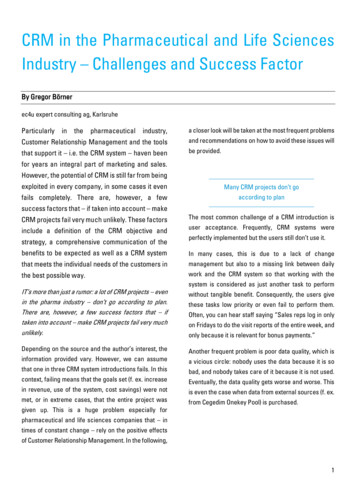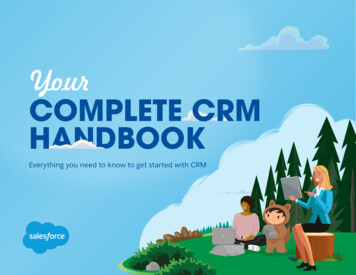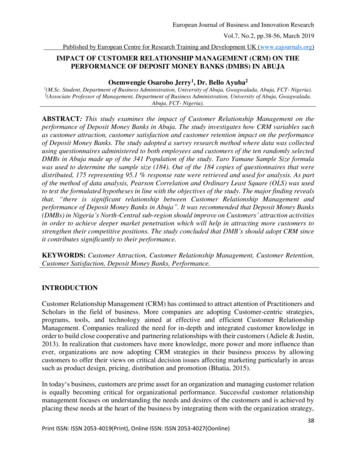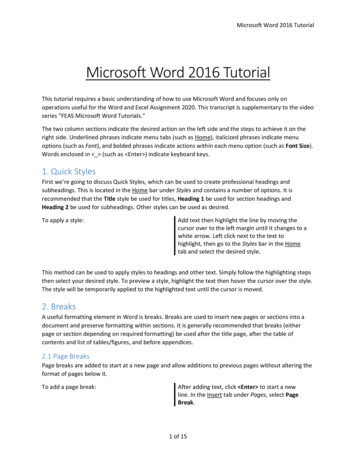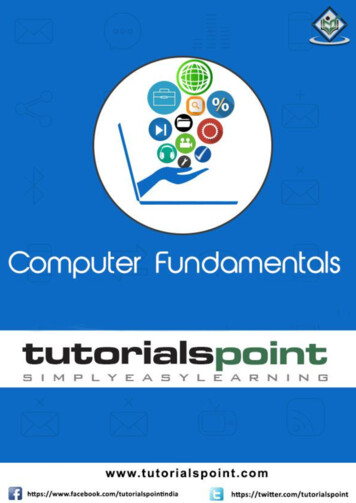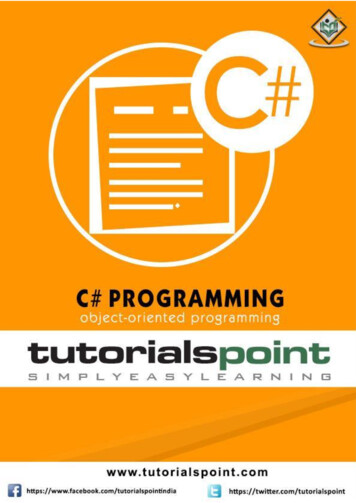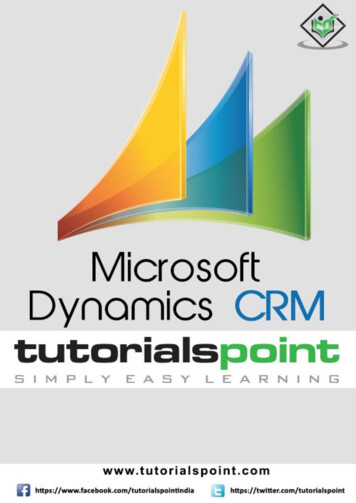
Transcription
Microsoft Dynamics CRMAbout the TutorialMicrosoft Dynamics CRM is a customer relationship management software packagedeveloped by Microsoft, focusing on enhancing customer relationships for anyorganization. It is one of the leading industry-standard CRM software available inmarket.The product focuses mainly on Sales, Marketing, and Customer Service sectors, howeverMicrosoft has been marketing Dynamics CRM as an XRM platform and has beenencouraging partners to use its proprietary (.NET based) framework to customize it.AudienceThis tutorial is targeted for Microsoft Dynamics CRM developers beginning to learnDynamics CRM or developers who are looking for a specific functionality of the product.This tutorial will bring you to the intermediate level of knowledge in Microsoft DynamicsCRM covering all the important aspects with complete hands-on experience.PrerequisitesMicrosoft Dynamics CRM is a product that runs completely on the Microsoft technologystack (ASP.NET, IIS, Microsoft Office, etc.). Hence, basic knowledge of ASP.NET and C#(or VB.NET) is needed. Also, this tutorial assumes that you already have Visual Studiosoftware installed on your system.Disclaimer & Copyright Copyright 2018 by Tutorials Point (I) Pvt. Ltd.All the content and graphics published in this e-book are the property of Tutorials Point(I) Pvt. Ltd. The user of this e-book is prohibited to reuse, retain, copy, distribute orrepublish any contents or a part of contents of this e-book in any manner without writtenconsent of the publisher.We strive to update the contents of our website and tutorials as timely and as preciselyas possible, however, the contents may contain inaccuracies or errors. Tutorials Point (I)Pvt. Ltd. provides no guarantee regarding the accuracy, timeliness or completeness ofour website or its contents including this tutorial. If you discover any errors on ourwebsite or in this tutorial, please notify us at contact@tutorialspoint.com.i
Microsoft Dynamics CRMTable of ContentsAbout the Tutorial . iAudience . iPrerequisites . iDisclaimer & Copyright. iTable of Contents . ii1.MICROSOFT DYNAMICS CRM OVERVIEW. 1Microsoft Dynamics CRM . 1Product Offerings . 1Accessing CRM . 2Product Competitors . 3Product Versions . 32.MICROSOFT DYNAMICS CRM ENVIRONMENT . 4Setting Up Microsoft Dynamics CRM Online Account . 4Downloading CRM SDK . 73.MICROSOFT DYNAMICS CRM FUNCTIONAL MODULES . 8Understanding CRM Functional Modules . 8Navigating CRM Work Areas . 9Sales Module . 11Marketing Module . 11Service Management Module . 12Activity Management . 12ii
Microsoft Dynamics CRM4.MICROSOFT DYNAMICS CRM ENTITIES &RECORDS. 14What is an Entity? . 14Creating a New Entity . 14Creating Records . 18Accessing Records . 20Updating Records . 21Deleting Records . 225.MICROSOFT DYNAMICS CRM FIELDS . 24Field Types . 246.MICROSOFT DYNAMICS CRM FORMS . 26Adding Fields on Form . 267.MICROSOFT DYNAMICS CRM SEARCHING . 36Quick Search . 36Advanced Search . 37Saving Custom View . 398.MICROSOFT DYNAMICS CRM WEB RESOURCES . 40Uses of Web Resources . 40Types of Web Resources . 41Accessing Web Resources for Any Entity . 419.MICROSOFT DYNAMICS CRM JSCRIPT WEB RESOURCES . 43Applications of JavaScript in CRM . 43Xrm.Page Object Model . 44Collections . 45Supported Events in Form Programming . 45iii
Microsoft Dynamics CRMForm Programming Example . 4610. MICROSOFT DYNAMICS CRM HTML WEB RESOURCES. 57Applications of HTML Web Resources . 57HTML Web Resource Example . 5711. MICROSOFT DYNAMICS CRM WORKFLOW PROCESSES . 65Synchronous/Asynchronous Workflow . 65Workflow Messages . 65Workflow Scope . 66Workflow Steps . 66Workflow Example . 67Workflow vs Plugin . 7512. MICROSOFT DYNAMICS CRM PLUGINS . 77Event Framework . 77Plugin Pipeline Stages . 77Plugin Messages . 78Writing Plugin . 79Signing the Plugin Assembly . 84Exception Handling in Plugins . 8613. MICROSOFT DYNAMICS CRM PLUGIN REGISTRATION. 87Connecting to the Server . 87Registering the Assembly . 89Registering the Plugin . 92Testing the Plugin . 95iv
Microsoft Dynamics CRM14. MICROSOFT DYNAMICS CRM WEB SERVICES . 97IDiscoveryService Web Service . 97IOrganizationService Web Service . 97IOrganizationService Web Service Methods . 98Web Service Example . 9815. MICROSOFT DYNAMICS CRM SOLUTIONS. 105Types of Solutions . 105Solution Components . 106Creating a Solution . 108Exporting a Solution . 109Importing a Solution . 112Conflict Resolution . 114v
1.Microsoft Dynamics CRMMicrosoft Dynamics CRM OverviewCustomer Relationship Management (CRM) is a system for managing a company’sinteractions with current and future customers. It often involves using technology toorganize, automate, and synchronize sales, marketing, customer service, and technicalsupport. CRM can help reduce costs and increase profitability by organizing andautomating business processes that nurture customer satisfaction and loyalty.Microsoft Dynamics CRMMicrosoft Dynamics CRM is a customer relationship management software packagedeveloped by Microsoft focused on enhancing the customer relationship for anyorganization. Out of the box, the product focuses mainly on Sales, Marketing, andCustomer Service sectors, though Microsoft has been marketing Dynamics CRM as anXRM platform and has been encouraging partners to use its proprietary (.NET based)framework to customize it. In recent years, it has also grown as an Analytics platformdriven by CRM.The CRM Solution can be used to drive the sales productivity and marketingeffectiveness for an organization, handle the complete customer support chain, andprovide social insights, business intelligence, and a lot of other out-of-the-boxfunctionalities and features. As a product, Microsoft Dynamics CRM also offers full mobilesupport for using CRM apps on mobiles and tablets.As of writing this tutorial, the latest version of CRM is CRM 2016. However, in thistutorial we will be using CRM 2015 Online version as it is the latest stable version as wellas frequently used in many organizations. Nevertheless, even if you are using any otherversions of CRM, all the concepts in the tutorial will still hold true.Product OfferingsMicrosoft Dynamics CRM is offered in two categories:CRM OnlineCRM Online is a cloud-based offering of Microsoft Dynamics CRM where all the backendprocesses (such as application servers, setups, deployments, databases, licensing, etc.)are managed on Microsoft servers. CRM Online is a subscription-based offering which ispreferred for organizations who may not want to manage all the technicalities involved ina CRM implementation. You can get started with setting up your system in a few days(not weeks, months or years) and access it on web via your browser.CRM On-PremiseCRM on-premise is a more customized and robust offering of Microsoft Dynamics CRM,where the CRM application and databases will be deployed on your servers. This offeringallows you to control all your databases, customizations, deployments, backups,licensing and other network and hardware setups. Generally, organizations who want togo for a customized CRM solution prefer on-premise deployment as it offers betterintegration and customization capabilities.1
Microsoft Dynamics CRMFrom the functional standpoint, both the offerings offer similar functionalities; however,they differ significantly in terms of implementation. The differences are summarized inthe following table.CRM OnlineCRM On-premiseThis is a cloud-based solution provided byMicrosoft in which all the servers anddatabases are managed by Microsoft.This is an on-premise solution provided byMicrosoft in which the servers anddatabases are managed by the customer.You can get started with an onlineoffering in a matter of few days. You payfor the users and used space on-the-go.Setting up an on-premise offering needstechnical skills as well as sufficient time tosetup the CRM instance and get it running.It supports relatively less customizationsand extensions.It supports relatively more customizationand extensions.CRM Online does not give the ability toperform manual data backup and restoreoptions, since the database is hosted onMicrosoft servers. However, Microsoftperforms daily backups of the database.CRM on-premise gives complete ability tomanage your database.CRM Online has various plans based onthe data storage limits such as 5GB, 20GB, etc.CRM on-premise does not have any suchlimits on storage size, since the data existson your own servers.CRM Online provides inbuilt capabilities offeatures such as insights, social listening,analytics, etc.CRM on-premise has extra costs for thesefeatures.CRM Online supports automatic updatesto future version.CRM on-premise updates needinstalled by the administrator.tobeAccessing CRMMicrosoft Dynamics CRM can be accessed via any of the following options: Browser Mobile and Tablets Outlook2
Microsoft Dynamics CRMProduct CompetitorsMicrosoft Dynamics CRM is undoubtedly one of the top products in the CRM space.However, following are the other products that compete with Microsoft Dynamics CRM. Salesforce.com Oracle SAP Sage CRM Sugar CRM NetSuiteProduct VersionsMicrosoft Dynamics CRM has grown over the years starting from its 1.0 version in 2003.The latest version (as of writing this article) is 2015. Following is the chronological list ofrelease versions: Microsoft CRM 1.0 Microsoft CRM 1.2 Microsoft Dynamics CRM 3.0 Microsoft Dynamics CRM 4.0 Microsoft Dynamics CRM 2011 Microsoft Dynamics CRM 2013 Microsoft Dynamics CRM 2015 Microsoft Dynamics CRM 20163
2.Microsoft Dynamics CRMMicrosoft Dynamics CRM EnvironmentLet's start by setting up our CRM environment. We will be using the online version ofCRM 2015, since the online version provides one-month free trial access. By doing this,you will not need to purchase any license to learn CRM.Note: Since Microsoft Dynamics CRM is a growing product, it is possible that by the timeyou are learning this, you will have a newer version of the product. In that case, theapplication may not look exactly as you would see in the screenshots of this tutorial.However, the core concepts of the product remain the same. The look-and-feel and thenavigation of the product may change, however, in most of the cases you will be able toeasily navigate and locate the required options.Setting Up Microsoft Dynamics CRM Online AccountStep 1: Navigate to the following ree-trial-overview.aspxIn case you do not see the options of Trial version via this link in future, just trysearching "Microsoft Dynamics CRM Free Trial" on Google.Step 2:Click the Try it free button. This will start a 3-step registration process as shownin the following screenshot. In Step 1 of 3-step registration, fill in the mandatory detailssuch as name, email, and language.4
Microsoft Dynamics CRMStep 3: In Step 2 of 3-step registration, create a user ID of your choice and set apassword for your account.Step 4:In Step 3 of 3-step registration, Microsoft will validate the mobile number thatyou have specified. For this, you can provide your mobile number and click Text me. Itwill then send an OTP to your mobile using which you will be able to proceed further withthe setup.5
Microsoft Dynamics CRMStep 5:Your Office 365 user ID will be created. You can save this user ID information forlater access.After setting up the account, it will now open your CRM Dashboard which will looksomething like the following.Just to emphasize again, the screenshots above may change with a future version,however setting up the environment will be a pretty simple process.6
Microsoft Dynamics CRMDownloading CRM SDKThe Software Development Kit (SDK) of Microsoft Dynamics CRM contains importantcode samples including server side code, client side code, extensions, plugins, webservices, workflows, security model, etc. Basically, the SDK contains every developmentresource that you would need to get started with CRM. Whether you are planning to setup a new plugin project or setting up a web services project for CRM, the SDK providesthe basic architecture and examples ranging from simple to advanced level to help youkick-off. We will now look at the steps to download and install the SDK.Step 1:Every version of Microsoft Dynamics CRM comes with its own SDK version. Thebest way to get the correct SDK version would be to search on Google for yourrespective CRM version. For example, if your CRM version is 2015, then try searching for"Microsoft Dynamics CRM 2015 SDK".Step 2:Once downloaded, run the exe setup. Click Continue.Step 3:It will ask you to choose the location where the SDK should be extracted. Selectany appropriate location where you would like to keep the reference SDK.Step 4: Open the folder where you had extracted. You can access all the SDK contentfrom here.ConclusionIn this chapter, we have set up our environment by creating a CRM Online account. Wethen downloaded the CRM SDK, which will be used in the subsequent chapters of thistutorial. Make sure to note down the credentials with which you have set up the account,since you will need these credentials the next time you login.7
3.Microsoft Dynamics CRMMicrosoft Dynamics CRM FunctionalModulesThe entire Microsoft Dynamics CRM is designed around the following functional modules. Sales Marketing Service ManagementThese functional modules are often called as Work Areas.Understanding CRM Functional ModulesThe entire CRM application is divided functionally for different types of users and teams.Hence, if an organization is using CRM to manage its processes, the users from the Salesteam would use the functionalities that come under the Sales module, while the usersfrom the Marketing team would use functionalities that fall under the Marketing module.All these three functional modules come together to drive the entire lifecycle of gaining anew customer (Marketing), selling them the services (Sales) and maintaining theexisting customers (Service Management).8
Microsoft Dynamics CRMTo understand this flow in a better way, consider a bank which sells credit cards to itscustomers. The typical lifecycle of selling a credit card to a customer would be as follows.In each step of this lifecycle, you will see how the Sales, Marketing and Service modulesperform their role.Sales & Marketing: The bank’s call center office executive receives data of potentialcustomers; often called as Leads in CRM. These Leads are captured in the CRM systemvia marketing campaigns, sales drives, referrals, etc.Sales: The call center executive communicates with these Leads either through phonecalls/emails/etc. If the customer is interested in the credit card offering, the Lead recordwill be converted to an Opportunity record (won Lead).Service: Once a customer becomes a part of the system, the company would assisthim/her with payments, billing, refunds, etc. Whenever the customer has any queries orconcerns, they will make a call to the call center and raise incidents. The executive willfollowup to resolve the case with the aim to provide quality service to the customer.These tasks fall under CRM Service Management.Navigating CRM Work AreasStep 1: Open CRM Home Page.Step 2: By default, you will see the Sales work area as selected.9
Microsoft Dynamics CRMStep 3: To change the work area, click the Show work areas option. You will see theoptions for selecting Sales, Service, and Marketing.Step 4: Click Sales. This will show you all the entities which fall under Sales such asAccounts, Contacts, Leads, Opportunities, Competitors, etc. Each of these entities arecategorized by their business process such as My Work, Customers, Sales, Collateral,etc.Step 5: Similarly, if you click the Marketing work area, you will see all the entitiesrelated to Marketing business functionalities.10
Microsoft Dynamics CRMSales ModuleThe Sales module of CRM is designed to drive the entire sales lifecycle of a newcustomer. The Sales module consists of the following sub-modules:Leads: Represents a person or an organization that can be a potential customer to thecompany in future. This is the first step towards getting a potential customer in thesystem.Opportunities: Represents a potential sale to the customer. Once a Lead shows interestin the offering, it gets converted to an Opportunity. An Opportunity will either be won orlost.Accounts: Represents a company with which the organization has relations. Once anOpportunity wins, it gets converted to either an Account or Contacts.Contacts: Represents a person, or any individual with whom the organization hasrelations. Mostly these Contacts are the customers of the organizations (e.g. all creditcard customers of a bank). Once an Opportunity wins, it gets converted to either anAccount or Contacts.Competitors: Manages all the market competitors of the organization.Products: Manages all the products offered by the organization to its customers(Example, all the credit card plans).Quotes: A formal offer for products or services proposed at specific prices sent to aprospective customer (Example, yearly pricing of a certain credit card plan sent to thecustomer).Orders: A quote that gets accepted by the customer turns into an Order (Example, outof all the plans that the organization offers you, you may go for a 6-month subscription).Invoices: A billed order generates an invoice.Marketing ModuleThe Marketing module of CRM is designed to drive the entire marketing process of anorganization for its existing and potential customers. The Marketing module consists ofthe following sub-modules:Marketing Lists: Provides a way to group your Contacts, Accounts, and Leads andinteract with them via sending promotional emails, event details, newsletters and otherupdates relevant to the target customers. You can define the criteria to create yourmarketing lists (Example, contacts aged between 25 and 35).Campaigns: Campaigns are designed to measure the effectiveness and accomplish aspecific result, such as introducing a new product or increasing the market share andmay include various communication channels such as email, newspaper ads, YouTubeads, etc.Quick Campaigns: A Quick Campaign is similar to Campaign however it can be relatedto only one type of activity.All the above Marketing modules work in close co-ordination with the Sales module.11
Microsoft Dynamics CRMService Management ModuleThe Service Management module of CRM is designed to focus, manage, and track thecustomer service operations of an organization such as supporting the incident-basedservices, supporting the customers using service scheduling, etc.The Service Management module covers the following sub-modules: Cases (Incidents): Supports any customer requests, issues, or complaints to betracked via incidents/cases. A case follows various stages of an issue resolutionprocess and then finally gets resolved and is closed. Knowledge Base: Maintains a master repository for all the common questionsand answers that the customer frequently asks. Contracts: Contracts work with Cases indicating all the active contracts that thecustomer has. Resources/Resource Groups: Represents the people, tools, rooms, or pieces ofequipment that are used to deliver a service. These resources can be used tosolve a specific customer issue. Services: Represents all the services that the organization offers to thecustomers. Service Calendar: Used to schedule work timings and schedules of the userswho work in the organization.Activity ManagementAll the modules explained above use the Activity Management module of CRM. AnActivity represents any kind of interaction with the customer such as a Phone Call, Email,Letter, etc. These activities can be related to any of the entities explained earlier such asAccount, Contact, Lead, Case, etc. By default, CRM provides following types of activitiesout-of-the-box: Phone Call Email Task Appointment Recurring Appointment Letter Fax Campaign Response Campaign Activities Service Activity Custom Activities12
Microsoft Dynamics CRMConclusionIn this chapter, we have learnt about the three major modules of CRM – Sales,Marketing, and Service Management. We understood how the work areas are organizedin CRM and how the entire lifecycle of a CRM organization works. We also looked at theActivity Management module of CRM which allows to create Phone, Email, Fax and othertypes of customer interaction activities.13
Microsoft Dynamics CRMEnd of ebook previewIf you liked what you saw Buy it from our store @ https://store.tutorialspoint.com14
Microsoft Dynamics CRM i About the Tutorial Microsoft Dynamics CRM is a customer relationship management software package developed by Microsoft, focusing on enhancing customer relationships for any organization. It is one of the leading industry-st

